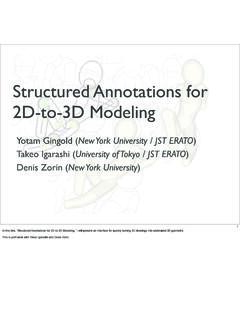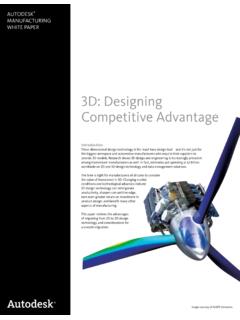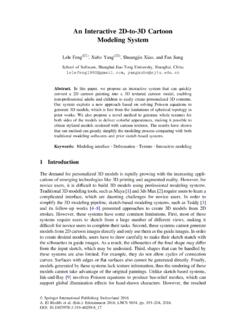Transcription of Structured Annotations for 2D- to- 3D Modeling
1 Structured Annotations for 2D- to- 3D ModelingYotam Gingold New York University / JST ERATOT akeo IgarashiUniversity of Tokyo / JST ERATOD enis ZorinNew York UniversityAbstractWe present a system for 3d modeling of free- form surfaces from2D sketches. Our system frees users to create 2D sketches from ar-bitrary angles using their preferred tool, which may include penciland paper. A 3D model is created by placing primitives and anno-tations on the 2D image. Our primitives are based on commonlyused sketching conventions and allow users to maintain a singleview of the model. This eliminates the frequent view changes in-herent to existing 3d modeling tools, both traditional and sketch-based, and enables users to match input to the 2D guide image.
2 Ourannotations same- lengths and angles, alignment, mirror symme-try, and connection curves allow the user to communicate higher-level semantic information; through them our system builds a con-sistent model even in cases where the original image is present the results of a user study comparing our approach to aconventional sketch- rotate- sketch [Methodology and Techniques]:Interactiontechniques [Computational Geometry and Object Modeling ]:Geometric algorithms, languages, and systemsKeywords:user interfaces, sketch- based Modeling , Annotations ,interactive Modeling , image- based modeling1 IntroductionTraditional 3d modeling tools ( [Autodesk 2009]) require usersto learn an interface wholly different from drawing or sculpting inthe real world.
3 2d drawing remains much easier than 3D model-ing, for professionals and amateurs alike. Professionals continueto create 2D drawings before 3d modeling and desire to use themto facilitate the Modeling process ([Thorm ahlen and Seidel 2008;Tsang et al. 2004; Eggli et al. 1997; Kallio 2005; Dorsey et al. 2007;Bae et al. 2008]). Sketch- based Modeling systems, such as Teddy[Igarashi et al. 1999] and its descendants, approach the 3D model-ing problem by asking users to sketch from many views, leveragingusers 2d drawing skills. In these systems, choosing 3D viewpointsremains an essential part of the workflow: most shapes can only becreated by sketching from a large number of different views. Theworkflow of these systems can be summarized as sketch- rotate-sketch.
4 Because of the view changes, users cannot match theirinput strokes to a guide image. Moreover, finding a good view fora stroke is often difficult and time- consuming: In [Schmidt et ], a 3D manipulation experiment involving users with a rangeof 3d modeling experience found that novice users were unable tocomplete their task and became frustrated. These novice users po-sitioned the chair parts as if they were 2D objects. The change ofviews is amajor bottleneckin these systems. e- mail: 1:Our Modeling process: the user places primitives andannotations on an image, resulting in a 3D is also used in the context of traditional Modeling sys-tems: a workflow often employed by professional 3D modelers isplacing axis- aligned sketches or photographs in the 3D scene forreference.
5 This workflow could potentially allow amateurs whocannot draw well in 2D to create 3D models from sketches pro-duced by others. Yet, paradoxically, this approach requires ahigherlevel of skill despite relying on easier- to- produce 2D sketches asa Modeling aid. This is because of the difficulty of using conven-tional tools, which require constant changes to the camera position,whereas a single view is needed to match an existing goal of our work is to design a user interface that simplifiesmodeling from 2D drawings and is accessible to casual users. Ide-ally, an algorithm could automatically convert a 2d drawing into a3D model, allowing a conventional sketch (or several sketches) toserve as the sole input to the system.
6 This would eliminate the needfor view point selection and specialized 3D UI tools. However,many (if not most) drawings are ambiguous and contain inconsis-tencies, and cannot be interpreted as precise depictions of any 3 Dmodel (Section 3). This limits the applicability of techniques suchas Shape- from- Shading ([Prados 2004]) and reconstruction fromline drawings ([Varley and Company 2007]). Humans apparentlyresolve many of the ambiguities and inconsistencies of drawingswith semantic knowledge. Our work provides an interface for usersto convert their interpretation of a drawing into a 3D shape. In-stead of asking the user to provide many sketches or sketch strokesfrom multiple points- of- view, we ask the user to provide all infor-mation in 2D from asingle view, where she can match her inputto the underlying sketch.
7 In our tool, user input takes the form of(1)primitives(generalized cylinders and ellipsoids) with dynamichandles, designed to provide complete flexibility in shape, place-ment, and orientation, while requiring a single view only, and (2)annotationsmarking similar angles, equal- length lines, connectionsbetween primitives, and symmetries, to provide additional seman-tic information. Our system generates 3D models entirely from thisuser input and does not use the 2D image, which may be inaccurate,inconsistent, sparse, or noisy. We do not expect that users have aconsistent 3D mental model of the shape and are specifying prim-itives precisely; we aim to create plausible, reasonable quality 3 Dmodels even if a user s input is have designed a system of user interface ele-ments implementing an intuitive and powerful paradigm for inter-active free- form Modeling from existing 2D drawings , based on theidea of describing an existing drawing by placing primitives present the results of a small user study showing that our inter-face is usable by artists and non- artists after minimal training anddemonstrating that the results are consistently better compared totools using the sketch- rotate- sketch workflow.
8 We demonstratethat our system makes it possible to create consistent 3D modelsqualitatively matching inconsistent resulting 3D models are collections of primitives containingstructural information useful in applications such as animation, de-formation, and further processing in traditional Modeling tools. Wedonotargue that one should perform all 3d modeling operationsin a 2D view. Our goal is to demonstrate that it is possible toaccelerate the creation of initial, un-detailed 3D models from 2 Dsketches, which can be further refined and improved using othertypes of Modeling Related WorkInteractive, single-view approach is most simi-lar in spirit to [Zhang et al. 2001] and [Wu et al. 2007], in whichusers annotate a single photograph or drawing with silhouette linesand normal and positional constraints; the systems solve for heightfields that match these constraints.
9 In our system, the primitives andannotations added by a user are Structured and semantic, and we areable to generate 3D models from globally inconsistent system rectifies the shape primitives placed by a user in orderto satisfy the user s Annotations (symmetries and congruencies).[Andre et al. 2007] presented a single-view Modeling system in-tended to mimic the process of sketching on a blank canvas. We aresimilarly motivated; our system allow users to preserve intact theprocess of sketching on a blank , multiple-view [Debevec et al. 1996] and[Sinha et al. 2008] and [van den Hengel et al. 2007], users markedges or polygons in multiple photographs (or frames of video).The systems extract 3D positions for the Annotations , and, in fact,textured 3D models, by aligning the multiple photographs.
10 (In [De-bevec et al. 1996], users align them to edges of a 3D model createdin a traditional way). In our system, users have only a single, poten-tially inconsistent drawing; these computer vision-based techniquesassume accurate, consistent input and hence cannot be applied toour , single-view sketch recognitiontechniques convert a 2D line drawing into a 3D solid model. Theseapproaches also typically assume a simple projection into the imageplane. Furthermore, a variety of restrictions are placed on the linedrawings, such as the maximum number of lines meeting at singlepoint, and the implied 3D models are assumed to be, for example,polyhedral surfaces. For a recent survey of line-drawing interpre-tation algorithms, see [Varley and Company 2007].










